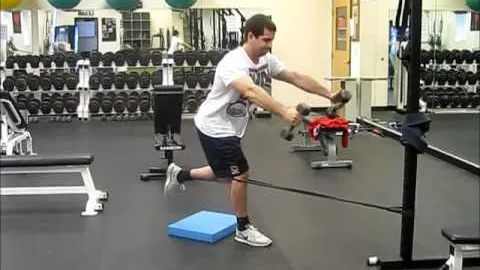
The skater squat with band is an effective and challenging exercise that targets the lower body, particularly the glutes, quads, and hamstrings. By incorporating resistance bands into this exercise, you can increase the difficulty and further activate your muscles. In this guide, we will break down the skater squat with band step by step and discuss its benefits and variations.
The skater squat with band offers several benefits, making it a valuable addition to your lower body workout routine. Here are some advantages of this exercise:
Strengthens Quadriceps: The skater squat with band helps to strengthen the quadriceps, specifically the vastus lateralis, vastus medialis, vastus intermedius, and rectus femoris. These muscles play a crucial role in knee extension and stability.
Activates Glutes: By performing the skater squat with band, you engage your gluteal muscles, including the gluteus maximus, gluteus medius, and gluteus minimus. These muscles contribute to hip extension and overall lower body strength.
Improves Balance and Stability: One of the primary benefits of the skater squat with band is its ability to enhance balance and stability. This exercise challenges your body's proprioception and strengthens the muscles responsible for maintaining stability.
Enhances Athletic Performance: The skater squat with band is a functional movement that mimics the lateral movements required in sports such as skating, skiing, and basketball. By incorporating this exercise into your training regimen, you can improve your athletic performance in these activities.
To properly execute the skater squat with band, follow these steps:
Starting Position: Begin by placing a resistance band just above your knees. Stand with your feet hip-width apart and parallel, and maintain a slight bend in your knees. Your arms should be relaxed by your sides.
Lunge to the Side: Take a large step to the right, shifting your weight onto your right leg. Keep your left foot off the ground and extend it out to the side.
Squat Down: Lower your body into a squat position by bending your right knee, pushing your hips back, and keeping your chest up. Engage your core and ensure that your knee does not extend beyond your toes.
Rise Back Up: Push through your right heel to rise back up to the starting position. Maintain control throughout the movement.
Repeat on the Other Side: Perform the skater squat on the left side by stepping to the left and repeating the same squatting motion.
Sets and Repetitions: Aim to complete 10-12 repetitions on each side, and gradually increase the number of sets as you become more comfortable with the exercise.
To add variety to your workout routine and target different muscles, you can try the following variations of the skater squat with band:
Elevated Skater Squat: Perform the skater squat with one foot elevated on a sturdy platform, such as a step or a box. This variation increases the range of motion and places more emphasis on the working leg.
Weighted Skater Squat: Hold a dumbbell or kettlebell in front of your chest while performing the skater squat. The added resistance will increase the difficulty and further challenge your muscles.
Plyometric Skater Squat: Introduce an explosive element to the skater squat by adding a jump after each squat. This variation enhances power and can be a great addition to your cardiovascular training.
While the skater squat with band is a highly effective exercise, it's essential to prioritize safety. Keep the following tips in mind:
Proper Form: Maintain proper form throughout the exercise, including a straight back, chest up, and knees in line with your toes. Avoid excessive forward lean and ensure your knee does not cave inward.
Start Slowly: If you are new to skater squats or resistance band training, start with lighter resistance bands and gradually increase the difficulty as your strength improves.
Listen to Your Body: Pay attention to any discomfort or pain during the exercise. If you experience any sharp or severe pain, stop the exercise immediately and consult a medical professional.
Warm-up and Cool-down: Always warm up your muscles with dynamic stretches or light cardio before performing the skater squat with band. Afterward, cool down with static stretching to prevent muscle soreness.
Incorporating the skater squat with band into your lower body workout routine can produce significant strength and stability gains. With its ability to target multiple muscle groups, enhance balance, and improve athletic performance, this exercise is a valuable addition to any fitness regimen. Remember to perform the skater squat with proper form, consider variations to challenge yourself, and prioritize safety at all times. Start reaping the benefits of the skater squat with band and take your lower body strength to new heights!
If you're looking for a gym, fitness club or yoga studio, you've come to the right place.
You can find information about gyms in your area. Browse catalog of gyms and find gyms with classes which are you looking for.
On gym page you can find simple information like address, phone or website. You can find list of available classes. You can check availability of personal training or small group classes. On place page you can also see information about open hours.
You can find gyms near you with amenities, courts, studios and equipments.
Use our map to find gym at your city or district.
In Gym Navigator you can find list of exercises with movies for many body parts.
You can browse exercises catalog and find exercises the best of you.
You can also find exercises grouped into workout plans, which you can use to improve you body. Each routine show you exercises one by one and give you possibility to count you progress and count down rest time.